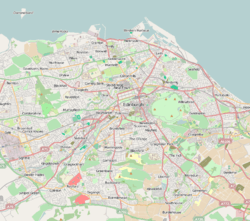Dundas House
| Dundas House | |
|---|---|
|
Dundas House, Edinburgh | |
| Location | St Andrew Square, Edinburgh |
| Coordinates | 55°57′17″N 3°11′27″W / 55.954623°N 3.190952°WCoordinates: 55°57′17″N 3°11′27″W / 55.954623°N 3.190952°W |
| Built | 1771 |
| Architect | Sir William Chambers |
Listed Building – Category A | |
| Official name: 36 St Andrew Square, Dundas House, Royal Bank of Scotland Head Office | |
| Designated | 13 April 1965 |
| Reference no. | 29705 |
 Location within Edinburgh | |
Dundas House is located at 36 St Andrew Square, Edinburgh, Scotland. It is the Registered Office of the Royal Bank of Scotland. It is protected as a category A listed building.[1]
Background
The site was owned by Sir Lawrence Dundas of Kerse in the mid 18th century. When the town council made plans for a New Town drawn up by James Craig in 1775, the site of Dundas House was shown as a proposed church, St. Andrews (hence St. Andrews Square), acting as a counterpart to St. George's Church on what became Charlotte Square (originally to be called George Square but another scheme took that name first). The two were separated by the New Town itself laid out on a formal grid centred on George Street, along which the two churches were to face each other.
Lord Dundas saw the layout and decided the church site would make a good site for a prestigious mansion, and retained the feu within the overall plan. Works began in 1772, prior to the council's formal adoption of the New Town plan, which then required minor adaption to accommodate this change. The proposed St Andrew's Church was subsequently built at a less prominent site at 13 George Street.
The house was built of robust pale grey sandstone from Ravelston Quarry around three miles to the west. It was designed by Sir William Chambers, a prominent architect of the day. It was completed in 1774. It was modelled on Marble Hill House in Twickenham.
In 1780 Hugo Arnot described the building as "incomparably the handsomest townhouse we ever saw".
Commercial use
Lord Dundas died in 1781 and his son inherited the house. Having no great desire to live here (then the site was in the midst of a huge building site as the New Town construction began) he sold the house to the government and it then became a Customs House. At this stage it gained the royal coat of arms in its pediment. Most of the original interior was lost in this conversion. One front room at first floor on the north side remains intact.
Dundas House was acquired by the Royal Bank of Scotland in 1825. The interior was radically altered over the next 3 years, including the building of the notable domed banking hall with star-shaped windows in the ceiling, which was added by the architect John Dick Peddie in 1857.
In 1972 the 19th century banking screens and counters were removed and replaced by white marble counters.
The dome

The magnificent banking hall is covered by a dome, pierced by stars in diminishing sizes towards its centre. The pattern is used as part of the design on the Royal Bank of Scotland's £5 note.
